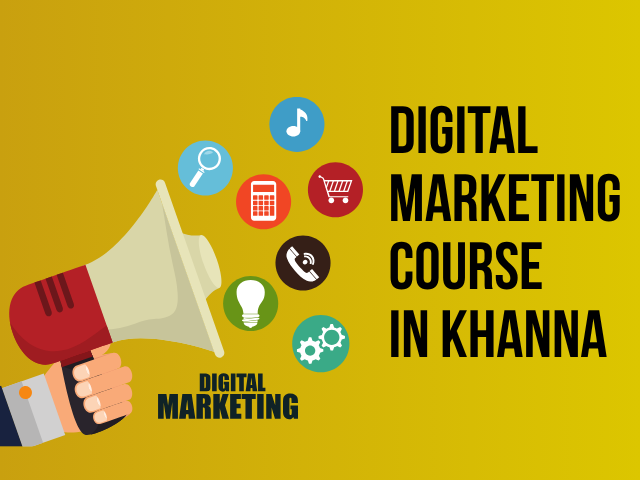Digital Marketing Course in Khanna – Boost Your Career with Future-Ready Skills
Digital Marketing Course in Khanna – Boost Your Career with Future-Ready Skills In today’s fast-growing digital world, every business—small or large—needs a strong online presence. Whether it is social media marketing, search engine optimization, content creation, or paid ads, digital marketing has become the backbone of modern business growth. With increasing demand, students, job seekers, and business owners in Khanna are actively looking for professional digital marketing courses to upgrade their skills and build stable careers. If you are someone who wants to explore career opportunities in this field, a Digital Marketing Course in Khanna can be the perfect step toward a successful future. Why Enroll in a Khanna Digital Marketing Course? Khanna is one of the rapidly developing cities in Punjab, and the demand for skilled digital marketers is rising every year. From retail shops and coaching institutes to real estate agencies and e-commerce stores, almost every business now relies on digital platforms. Learning digital marketing in Khanna provides an excellent opportunity to build skills locally without traveling to major cities like Chandigarh or Ludhiana. Another major advantage is that institutes in Khanna offer practical training with real projects, making the learning experience more job-oriented and helpful for beginners. What You Will Learn in a Digital Marketing Course A well-structured digital marketing course covers a wide range of modules that prepare you for the industry. Some core topics include: 1. Search Engine Optimization (SEO) You will learn how to optimize websites, improve rankings on Google, research keywords, build backlinks, and analyze SEO performance. SEO is one of the most in-demand skills for online success. 2. Social Media Marketing (SMM) This includes running ads and managing business pages on Facebook, Instagram, YouTube, and LinkedIn. You will learn how to create social media strategies, increase reach, and generate leads. 3. Google Ads / PPC Advertising Paid advertising is a powerful tool for businesses. During the course, you will learn how to set up campaigns, manage budgets, select targeting options, and track performance using Google Analytics. 4. Content Marketing Content plays a major role in digital growth. The course will teach you how to create engaging blogs, website content, social media posts, and SEO-friendly articles. 5. Email Marketing You will learn how to design newsletters, create automated email flows, and use email marketing tools for improving engagement. 6. Affiliate Marketing This module teaches you how to earn money by promoting products online. Many students in Khanna join digital marketing to start their own affiliate income streams. 7. Website Designing Basics Some institutes also provide basic WordPress training so that students can create and manage simple websites without coding. 8. Analytics & Reporting Understanding data is essential. You will learn Google Analytics, insights, reports, and tools that help businesses track performance and make decisions. Who Can Join a Digital Marketing Course in Khanna? A digital marketing course is suitable for: Students looking for career opportunities Job seekers wanting high-growth fields Entrepreneurs that wish to advertise their companies online Housewives and freelancers seeking work-from-home income Professionals who want to upgrade skills There is no age limit and no technical background required. Anyone with basic computer knowledge can start learning digital marketing easily. Career Opportunities After Completing the Course Digital marketing offers a wide range of job roles, such as: SEO Executive Digital Marketing Manager Social Media Manager Google Ads Specialist Content Writer Affiliate Marketer Freelance Digital Marketer YouTube and Social Media Strategist There are thousands of job opportunities in Punjab, and skilled individuals can even work remotely for companies across India and abroad. Why Digital Marketing Is the Future The digital industry is growing faster than ever. According to global trends, businesses are shifting from traditional marketing to online platforms. More companies in Khanna are investing in digital ads, websites, and online presence. This means the demand for digital marketers will continue rising in the coming years. Additionally, digital marketing allows you to earn from multiple sources, such as freelancing, affiliate marketing, and YouTube, giving you complete financial flexibility. Benefits of Learning Digital Marketing in Khanna 1. Practical Training Most institutes provide hands-on live project training, which helps students gain confidence. 2. Affordable Fees Compared to big cities, Khanna offers high-quality training at budget-friendly prices. 3. Experienced Trainers Institutes in Khanna often have trainers with real industry experience who guide students with advanced techniques. 4. Job Assistance Some institutes also offer placement support, helping students find internships and full-time jobs. How to Choose the Best Digital Marketing Institute in Khanna When selecting an institute, consider these important factors: Updated and detailed course syllabus Practical training with live projects Experienced and certified trainers Feedback from previous students Placement support and internship opportunities Affordable fees with value for money Take demo classes whenever possible to ensure the teaching style suits you. Conclusion A Digital Marketing Course in Khanna can open the doors to countless opportunities. Whether you want to build a high-income career, promote your business, or start freelancing, this course provides all the essential skills you need in today’s digital age. With proper training, dedication, and practice, you can build a successful career and stay ahead in this competitive world. Ready to get started learning Digital Marketing Course in Khanna – Boost Your Career with Future-Ready Skills? Register for a Free Demo. Get more details regarding Powerpoint Phone no. 9988-500-936 Address SCF 22, First floor, GTB Market, Khanna Website www.microwavecomputer.com Opening Hours 08:30 am – 06:00 pm Online Dropshipping Course Near me Online Dropshipping Course Near me The Best Dropshipping Course Digital Marketing Course Near me Digital Marketing Course with ChatGPT Leave a Reply Cancel Reply Logged in as admin. Edit your profile. Log out? Required fields are marked * Message*




